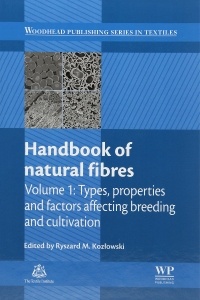Description
Handbook of Natural Fibres
Author: Kozlowski Ryszard M.
Language: English
Subject for Handbook of Natural Fibres:
Publication date: 10-2012
1200 p. · 15.5x23.2 cm · Hardback
Out of Print
1200 p. · 15.5x23.2 cm · Hardback
Out of Print
Description
/li>Biography
/li>Comment
/li>
Growing awareness of environmental issues has led to increasing demand for goods produced from natural products, including natural fibres. The two-volume Handbook of natural fibres is an indispensible tool in understanding the diverse properties and applications of these important materials.Volume one is an essential guide to a wide range of natural fibres, and highlights key techniques for their improvement. Part one reviews key types and fundamental properties of cotton, bast, silk, wool and bioengineered natural textile fibres. Part two goes on to explore the improvement of natural fibre properties and production through breeding and cultivation, beginning with a discussion of fibrous flax and cotton. Improved natural fibre production through the prevention of fungal growth is explored, along with the use of genetic engineering and biotechnology to enhance desirable characteristics in natural fibres.Volume two focuses on key processing techniques for the improvement and broader application of natural fibres.
Professor Ryszard M. Kozlowski is the award-winning former Director of the Polish Institute of Natural Fibres and Medicinal Plants. He is an Honorary Fellow of the Textile Institute, Editor-in-Chief of the Journal of Natural Fibres, Scientific Advisor to the Institute for Engineering of Polymer Materials and Dyes, and Doctor Honoris Causa of the Pontifical Catholic University of Ibarra, Ecuador. Professor Koz?owski is also Coordinator of both ESCORENA (the European System of Cooperative Research Networks in Agriculture and the FAO/ESCORENA European Cooperative Research Network on Flax and other Bast Plants. He is the author/co-author of over 300 publications, including 26 books and 25 patents.
- Provides an essential guide to a wide range of natural fibres and highlights key techniques for their improvement
- Reviews key types and fundamental properties of natural textile fibres, addressing the production, identification and testing of a range of cotton, bast, silk and wool fibres
- Focuses on key processing techniques for the improvement and broader application of natural fibres
© 2024 LAVOISIER S.A.S.




